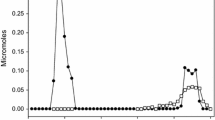Abstract
The cation [Cr3O(O2CCH2CH3)6(H2O)3]+ has been shown in vitro to mimic to the oligopeptide chromodulin’s ability to stimulate the tyrosine kinase activity of insulin receptor and shown in healthy and type 2 diabetic model rats to increase insulin sensitivity and decrease plasma total and low-density lipoprotein cholesterol and triglycerides concentrations. However, the degree to which the complex is absorbed after gavage administration to rats had not been previously determined. The biomimetic cation at nutritional supplement levels is absorbed with greater than 60% efficiency, and at pharmacological levels, it is absorbed with greater than 40% efficiency, an order of magnitude greater absorption than that of CrCl3, Cr nicotinate, or Cr picolinate, currently marketed nutritional supplements. The difference in degree of absorption is readily explained by the stability and solubility of the cation.
Similar content being viewed by others
References
J. B. Vincent, The bioinorganic chemistry of chromium(III). Polyhedron 20, 1–26 (2001).
P. Trumbo, A. A. Yates, S. Schlicker, et al., Dietary reference intakes: vitamin A, vitamin K, arsenic, boron, chromium, copper, iodine, iron, manganese, molybdenum, nickel, silicon, vanadium, and zinc. J. Am. Diet. Assoc. 101, 294–301 (2001).
M. H. Pittler, C. Stevinson, and E. Ernst, Chromium picolinate for reducing body weight: meta-analysis of randomized trials. Int. J. Obes. 27, 522–529 (2003).
S. L. Nissen and R. L. Sharp, Effect of dietary supplements on lean mass and strength gains with resistance exercise: a meta-analysis. J. Appl. Physiol. 94, 651–659 (2003).
J. B. Vincent, The potential value and potential toxicity of chromium picolinate as a nutritional supplement, weight loss agent, and muscle development agent. Sports Med. 33, 213–230 (2003).
M. D. Althuis, N. E. Jordan, E. A. Ludington, et al., Glucose and insulin responses to dietary chromium supplements: A meta-analysis. Am. J. Clin. Nutr. 76, 148–155 (2002).
R. A. Anderson, N. A. Bryden, and M. M. Polansky, Lack of toxicity of chromium chloride and chromium picolinate in rats. J. Am. Coll. Nutr. 16, 273–279 (1997).
Y. Sun, K. Mallya, J. Ramirez, et al., The biomimetic [Cr3O(O2CCH2CH3)6(H2O)3]+ decreases cholesterol and triglycerides in rats: towards chromium-containing therapeutics. J. Biol. Inorg. Chem. 4, 838–845 (1999).
Y. Sun, B. J. Clodfelder, A. A. Shute, et al., The biomimetic [Cr3O(O2CCH2CH3)6(H2O)3]+ decreases plasma insulin, cholesterol and triglycerides in healthy and type II diabetic rats but not type I diabetic rats. J. Biol. Inorg. Chem. 7, 852–862 (2002).
J. B. Vincent, Elucidating a biological role for chromium at a molecular level. Acc. Chem. Res. 33, 503–510 (2002).
C. M. Davis, A. C. Royer, and J. B. Vincent, Synthetic multinuclear chromium assembly activates insulin receptor kinase activity: functional model for low-molecular-weight chromium-binding substance. Inorg. Chem. 36, 5316–5320 (1997).
O. Wada, G. Y. Wu, A. Yamamoto, et al., Purification and chromium-excretory function of low-molecular-weight, chromium-binding substances. Environ. Res. 32, 228–239 (1983).
A. A. Shute and J. B. Vincent, The stability of the biomimetic cation triaqua-μ-oxohexapropionatotrichromium(III) in vivo in rats. Polyhedron 20, 2241–2252 (2001).
A. A. Shute and J. B. Vincent, The fate of the biomimetic cation triaqua-μ-oxohexapropionatotrichromium(III) in rats. J. Inorg. Biochem. 89, 272–278 (2002).
A. Earnshaw, B. N. Figgis, and J. Lewis, Chemistry of polynuclear compounds. Part VI. Magnetic properties of trimer chromium and iron carboxylates. J. Chem. Soc. A 1656–1663 (1966).
R. A. Anderson and M. M. Polansky, Dietary and metabolic effects of trivalent chromium retention and distribution in rats. Biol. Trace Element Res. 50, 97–108 (1995).
M. L. Davis-Whiteneck, M. S. Bernice, B. O. Adeleye, et al., Biliary excretion of 51chromium in bile-duct cannulated rats. Nutr. Res. 16, 1009–1015 (1996).
R. A. Anderson and A. S. Kozlovsky, Chromium intake, absorption and excretion of subjects consuming self-selected diets. Am. J. Clin. Nutr. 41, 1177–1183 (1985).
K. L. Olin, D. M. Stearns, W. H. Armstrong, et al., Comparative retention/absorption of 51chromium (51Cr) from 51Cr chloride, 51Cr nicotinate and 51Cr picolinate in a rat model. Trace Elements Electrolytes 11, 182–186 (1994).
R. A. Anderson, N. A. Bryden, M. M. Polansky, et al., Dietary chromium effects on tissue chromium concentrations and chromium absorption in rats. J. Trace Elements Exp. Med. 9, 11–25 (1996).
K. F. Kingry, A. C. Royer, and J. B. Vincent, Nuclear magnetic resonance studies of chromium(III) pyridinecarboxylate complexes. J. Inorg. Biochem. 72, 79–88 (1998).
G. W. Evans and D. J. Pouchnik, Composition and biological activity of chromium-pyridine carboxylate complexes. J. Inorg. Biochem. 49, 177–187 (1993).
N. E. Chakov, R. A. Collins, and J. B. Vincent, A re-investigation of the electronic spectra of chromium(III) picolinate complexes and high yield synthesis and characterization of Cr2(μ-OH)2(pic)4·5H2O (Hpic=picolinic acid). Polyhedron 18, 2891–2897 (1999).
W. T. Cefalu, Z. Q. Wang, X. H. Zhang, et al., Oral chromium picolinate improves carbohydrate and lipid metabolism and enhances skeletal muscle Glut-4 translocation in obese, hyperinsulinemic (JCR-LA corpulent) rats. J. Nutr. 132, 1107–1114 (2002).
J. K. Speetjens, A. Parand, M. W. Crowder, et al., Low-molecular-weight chromium-binding substance and biomimetic [Cr3O(O2CCH2CH3)6(H2O)3]+ do not cleave DNA under physiologically-relevant conditions. Polyhedron 18, 2617–2624 (1999).
D. M. Stearns, S. M. Silveira, K. K. Wolf, et al., Chromium(III) tris(picolinate) is mutagenic at the hypoxanthine (guanine) phopshoribosyl transferase locus in Chinese hamster ovary cells. Mutat. Res. 513, 135–142 (2002).
D. D. D. Hepburn, J. Xiao, S. Bindom, et al., Nutritional supplement chromium picolinate causes sterility and lethal mutations in Drosophila melanogaster. Proc. Natl. Acad. Sci., USA 100, 3766–3771 (2003).
Author information
Authors and Affiliations
Rights and permissions
About this article
Cite this article
Clodfelder, B.J., Chang, C. & Vincent, J.B. Absorption of the biomimetic chromium cation triaqua-μ3-oxo-μ-hexapropionatotrichromium(III) in rats. Biol Trace Elem Res 98, 159–169 (2004). https://doi.org/10.1385/BTER:98:2:159
Received:
Accepted:
Issue Date:
DOI: https://doi.org/10.1385/BTER:98:2:159




